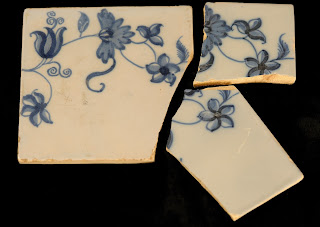This week in our
travels through Pennsylvania, we are going to take time out to congratulate
some special people who have made a difference in Pennsylvania archaeology.
First, the W. Fred
Kinsey Scholarship was awarded this year to senior Morgan Rouscher of
Gettysburg College. Morgan presented her
paper “Working Together: Exploring the Use of Public Archaeology in Waynesboro,
PA” at the 84th annual meeting of the Society for Pennsylvania
Archaeology in Uniontown. Award of this
scholarship provides students with recognition of their research endeavors and
encourages participation in a forum that focuses on Pennsylvania archaeology. Papers
selected for this award are subsequently edited and reviewed for publication in
the journal Pennsylvania Archaeologist. The
first scholarship recipient, Jonathan R. Libbon, was published in the Fall 2012
issue of the journal and last year’s recipient, Jennifer Rankin is scheduled
for publication later this year.
Ms. Roucher accepting the W. Fred Kinsey Scholarship Award at the 84th Annual Society for Pennsylvania Archaeology meeting
The W. Fred Kinsey Scholarship program began in 2011 in
an effort to promote student participation at the annual meetings of the
Society. Dr. Kinsey was a curator with the Pennsylvania Historical and Museum
Commission (PHMC) in the late 1950 and early 1960s. This was followed by twenty
five years at Franklin and Marshall College and The North Museum in Lancaster
County. His work on the prehistory of the Upper Delaware river valley laid the
foundation for much of the interpretation of this region of Pennsylvania. In
addition to his contributions to archaeological investigations, he mentored
many students who went on to become significant archaeologists on their own
merits.
Morgan’s paper focused on an eighteenth century rural farmstead
site which was occupied by one German Baptists family, the Stoner’s, from 1740
to 1850. Assistance with this excavation
was provided by members of Cumberland Valley Chapter #27 of the Society for
Pennsylvania Archaeology. This site
provides an opportunity to document the daily activities of a working farm
through the archaeological evidence recovered during excavations. Farmstead
sites typically provide an opportunity to examine agricultural practices- where
areas were fenced, barn construction methods and size, number and location of
outbuildings, and general land use patterns. Artifacts recovered during this investigation
will be analyzed for indicators of consumerism- local or imported, duration for
which the product was used and conditions under which it was discarded. These
questions provide archaeologists a chance to compare a working farm, occupied
by German Baptists in this case, with farms operated by other ethnic groups who
settled in Pennsylvania. This site type
is also a perfect connection for the local community to connect to their past
in ways that more renowned sites might not. Morgan selected this site’s public
involvement as a chance to educate the local community as to the value of
archaeology to them and everyone’s understanding of the past.
We wish to congratulate Morgan on her accomplishment and
hope to assist her with development of her paper for publication.
Our second award winner is Janet
Johnson, Curator, The State Museum of Pennsylvania. Janet received the highest
honor conferred on a professional archaeologist by the Society for Pennsylvania
Archaeology, the J. Alden Mason Award. The following was read for her award.
Janet Johnson accepting the J. Alden Mason award at the 84th Annual Society for Pennsylvania Archaeology meeting
This award is in honor of John Alden Mason. He was a
noted North and South American Archaeologist, a professor at the University of
Pennsylvania, and a founding member of Society for Pennsylvania Archaeology,
Inc. (SPA). This award is presented to a professional archaeologist or a
professional in a related science and is based upon his/her contribution to
education and encouragement of SPA members in the proper pursuit of
archaeology.
The Archaeology Section of the State Museum of Pennsylvania
houses over 4.5 million artifacts. When need to do some research, or
to examine artifacts, or to ask questions; we turn to the person who is always
there when we need her. She works long hours facilitating the care of material
remains of historic and prehistoric peoples who called Pennsylvania their
home. In her trust is our precious Pennsylvania history. She is a
tireless supporter of archaeology and goes the extra mile to make archaeology
accessible to SPA members, students, researchers and the general public.
Janet Johnson began as an intern at the State Museum of
Pennsylvania in 1979 and joined the staff in 1993. In 2004 she was promoted to
curator. Curator, Janet Johnson encourages the use of the museum’s
collections for education and research, and in spite of her busy work schedule
she makes herself available to aide persons doing research. She is especially
good with young researchers and mentors high school and college students.
Janet understands that Pennsylvania archaeology cannot grow without encouraging
students.
Janet is in charge of volunteers at the museum, is on the SPA
C14 committee and helped establish the Kinsey scholarship. She has
participated at various excavations in Pennsylvania, including Fort
Hunter. Janet works closely each year with the archaeology exhibits at
the Pennsylvania Farm Show, which is a major event that encourages interest in
Pennsylvania archaeology. Janet published with McConaughy in 2003 - Sugar Run
Mound and Village and with Kent, Rice, and Ota in 1981 - A map of
18th Century Indian towns in Pennsylvania.
Her most recent
research has focused on New Deal historical archaeology in Pennsylvania.
Janet, is also working with the Virtual Curation Laboratory at Virginia
Commonwealth University, regarding Susquehannock animal and human effigies on
vessels and smoking pipes.
For her many contributions to archaeology and dedication to
the principles of the Society for Pennsylvania Archaeology, Janet Johnson is
presented with the J. Alden Mason Award.
For more information, visit PAarchaeology.state.pa.us or the Hall of Anthropology and Archaeology at The State Museum of Pennsylvania .

















